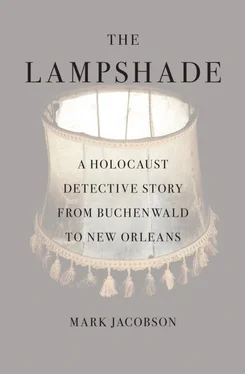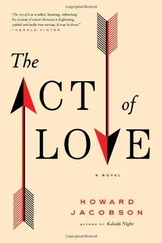With the lampshade samples already on their way to the DNA lab, it was no stretch for me and my fellow riders to count ourselves lucky that the Nazis had made their grab for racial hegemony when they did. A mere seven decades after the promulgation of Laws for the Protection of German Blood and German Honor in 1935, which among other things forbade “the extramarital sexual intercourse between Jews and subjects of the state of Germany or related blood,” it was sobering to imagine what the Hitlerites might have accomplished had they cracked the genetic code. With their zealous Teutonic genius for organization, what chance would supposed lesser beings have had if Mengele’s mad alchemist notions of turning brown eyes blue had been replaced by a technology capable of producing a complete chromosomal profile from a single strand of hair?
Shiya sent the lampshade samples to the Bode Technology Group, a well-known genetic analysis laboratory in Lorton, Virginia, outside Washington D.C. In the aftermath of the 9/11 disaster, the New York medical examiner’s office had done a lot of business with Bode and Shiya had been impressed by the results.
“Medical knowledge tends to expand during wartime, and nine-eleven was no different. The science of DNA identification grew up on the back of nine-eleven,” Shiya explained, adding that despite the lab’s distressing address on Furnace Road, Bode had the best chance of making an analysis of the aged and desiccated lampshade cutting. “Nobody can do what they do,” he said.
A quick look at the corporate history of the Bode company, however, was a bit unsettling. Founded by Tom Bode in 1995 as a midsized laboratory providing DNA identification primarily to law enforcement agencies in sexual assault and paternity cases, the lab was purchased in May 2001 by ChoicePoint, a leading “data aggregation” company with strong ties to Republican Party heavyweights in both the public and the private sectors. Onetime CIA operative and Bush administration undersecretary of state Richard Armitage was a former CEO; John Ashcroft served as the firm’s main Washington lobbyist after his run as U.S. attorney general. Despite involvement in a number of controversial episodes, including the 2000 Florida presidential vote counting, by 2005 ChoicePoint was maintaining seventeen billion separate records dealing with individuals and businesses. In 2007 Bode was sold again, this time to the GlobalOptions Group, another Pynchonesque-named concern whose advisory board included two former FBI directors, William Sessions and William Webster. At this point, Howard Safir, once Rudolph Giuliani’s largely ceremonial police commissioner, now head of the GlobalOptions Security Consulting and Investigations division, became Bode’s CEO. Although primarily known in law enforcement circles for once busting acid guru Timothy Leary and being related to Louis Weiner, the detective who arrested bank robber Willie Sutton, Safir was a strong advocate of the commercial possibilities of DNA typing in the security industry. Shortly after he took over at Bode, the New York Daily News ran a story questioning whether $20 million of NYPD contracts with the lab during Safir’s tenure as police commissioner had been “extended without competition from other bidders.”
Asked if he worried about the potential exploitation of such a powerful identification tool as DNA sampling for political, commercial, and/or privacy-invading reasons, Dr. Robert Bever, vice president and head research and development officer at Bode Technology, sat in his office on Furnace Road and offered only a small smile. A cautiously friendly man whose wire-rimmed glasses and short-sleeved white shirt give him the aspect of an earnest colonial missionary, Bever is not given to making global comments, especially when they might reflect upon his boss.
Originally trained as a microbiologist, Bever, now in his early fifties, began in the forensic DNA business working on paternity cases in a lab he set up in his garage. “It was all test tubes and used Volvo parts,” he said. Author of many peer-reviewed articles with titles like “Utilization of a Robotic Workstation, Fitzco FTA Paper and the Promega Powerplex to Optimize Laboratory Procedures for the Analysis of STR Loci,” Bever first came to Bode in the late 1990s and has been head of R & D for the past half dozen years.
“I think about the implications of this work, the way it might possibly be misused,” said Bever in between phone calls with technicians. “We’re dealing with the structure of life itself. You can’t approach that from a totally technical point of view. This is something I think about—the big picture, the context of our world within all of Creation. In the office, however, we must look through a different lens. Here, all that matters is what can be seen at the end of the microscope. The results. As a scientist and a believer, I don’t have any problem with this juxtaposition. There’s no real contradiction to me.”
When it came to the lampshade, however, Bever acknowledged an added complication, offering a personal note about how a number of his family members had just managed to escape the Nazis. “They left only a couple of weeks before Hitler closed the border… That disrupted their lives forever. Sometimes I think how my own life would have been different if that hadn’t happened,” Bever related, in his measured tone. “When you bring in something like this, a lampshade, with all the stories attached to it, you can’t call it just another sample. But it is our job to treat it like that.” Still, it was something of a coincidence, my bringing the lampshade to Bode, Bever added, since Jared Latiolais, the research scientist who would be doing the actual DNA testing, was from New Orleans and still had many family members there, several of whom had been displaced by Hurricane Katrina.
Bever would not guarantee any success. He agreed with what Shiya Ribowsky had told me: “With a sample from a living being or someone recently deceased, there will always be a lot of genetic information. The human body is like a wet sponge, DNA-wise. You just have to squeeze it. With this lampshade, the age of it and state of degradation, that’s very problematic. With these kinds of samples, what we’re doing is trying to wring a bit of life out of death. Some things are more dead than others.”
From the start, Bob Bever was fairly certain that any meaningful DNA identification of the lampshade would be of the mitochondrial variety. There are two varieties of DNA to be found in every cell. The vast majority of genetic information is in the nucleus. This is the nucleotide DNA, the site of Crick and Watson’s double helix, the full ledger of a being’s hereditary dossier. However, as Bever made clear, nuclear DNA is relatively fragile, susceptible to degradation in the face of excessive moisture and sunlight, which was a problem since if there was anything New Orleans had in abundance, outside of bon temps and drive-by shootings, it was heat and humidity. [7] But the bon temps does not rouler for long in the Crescent City. Only two months after Skip Henderson received the sacrament of Ash Wednesday, he was back on the Bus, in emergency mode. On Tuesday, April 20, 2010, the 121st anniversary of Adolf Hitler’s birth, the Deepwater Horizon rig blew up in the Gulf of Mexico, fifty miles off the Louisiana coast. Eleven people were killed and the resulting spill, the biggest in American history, threatens to wipe out the fishing industry on the Gulf Coast and befoul millions of acres of wetlands. Even as the Treme TV show reprised the nightmare life following Katrina on HBO, the fabled, wounded city suffered another blow. Again, the old, bad feeling of neglect from both the private and public sectors was ambient. One thing that was sure, the price of a po’ boy made with real, unfrozen shrimp was going to go through the roof. From Skip Henderson’s point of view, it meant more weeks of getting up at four thirty in the morning to drive the Bus down to Port Sulphur in Plaquemines Parish. The Plaquemines unemployment office was wrecked in the storm and never rebuilt, so Skip was enlisted to help out. “I am the Plaquemines Parish unemployment office,” he wailed. What was worse was the return of the national media to the Louisiana coast. Skip called me the other day from Port Sulphur to complain about the way things were going, when a loud noise came across the line. Screaming over the din, Skip said, “They’re landing a goddamn helicopter, right next to the Bus. There’s no end to this.”
Читать дальше












